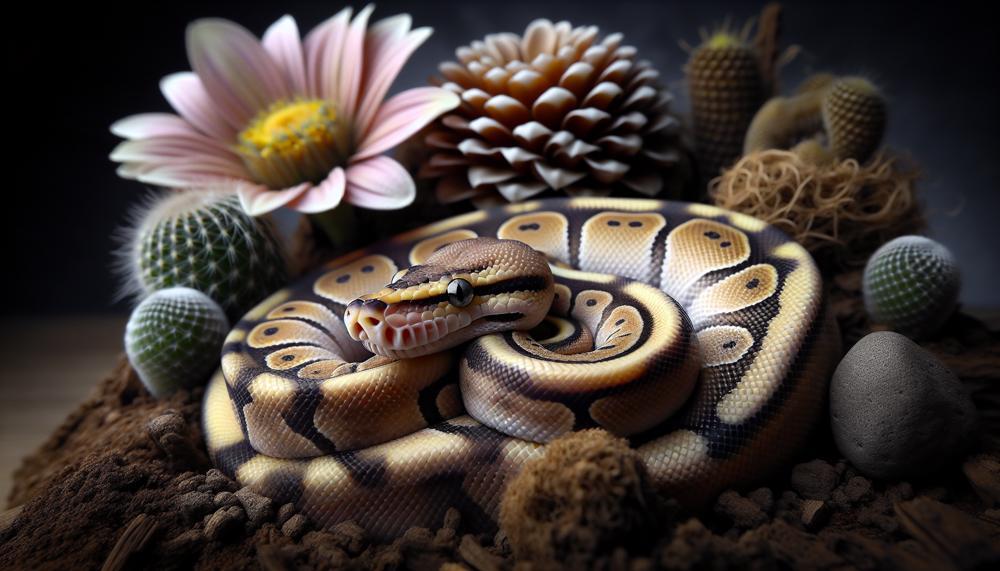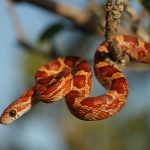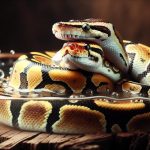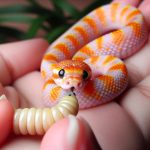Are you a night owl? Do you find yourself staying up late, watching the stars twinkle and the world quiet down? Well, it turns out that ball pythons share your love for the night. These captivating creatures have captured the hearts of reptile enthusiasts with their unique behaviors and stunning appearance. And one of their most intriguing traits is their nocturnal nature.
Yes, you heard that right. Ball pythons are primarily active at night. While it may seem like they’re just sleeping all day, there’s actually a lot more going on behind those beady eyes. In the wild, these slithery serpents use the cover of darkness to hunt for prey and avoid predators. With specially adapted eyes that excel in low-light conditions, they are masters of stealth in the dark.
But what about when they’re kept as pets? Well, here’s where things get interesting. Ball pythons may adjust their sleep schedule to match that of their owners, but they still need periods of darkness to maintain a healthy circadian rhythm.
During the day, you might find them nestled in a cozy hiding spot, conserving energy for their nighttime adventures.
And speaking of adventures, did you know that ball pythons are also more active during dawn and dusk? These times mimic their natural hunting hours and can bring out their playful side. Some owners even choose to provide artificial lighting for their ball pythons during the day to simulate natural sunlight.
So, next time you see your beloved ball python curled up in its hide during the day, don’t be fooled into thinking it’s just lazy or boring. It’s simply saving its energy for an exciting night ahead.
Keep exploring and learning about these amazing creatures, and embrace your inner night owl with your nocturnal pet by your side.
Contents
- 1 Ball Pythons Are Nocturnal
- 2 Do Ball Pythons Sleep?
- 3 Ball Pythons Have Specialized Eyes
- 4 Nocturnal Ball Pythons Can Sense Infrared Heat
- 5 Ball Pythons Use Pit Organs To Hunt in the Dark
- 6 Pet Owners Must Ensure Their Ball Python Gets Enough Sleep
- 7 Ball Python Enclosure Requirements
- 8 Nocturnal vs. Diurnal: What’s the Difference?
- 9 Conclusion
Ball Pythons Are Nocturnal
Yes, ball pythons are nocturnal. Ball pythons are known for their nocturnal nature, meaning they are most active at night. This is because of their natural habitat in Sub-Saharan Africa, where daytime temperatures can be too high for them to comfortably move around and hunt for prey.
As opportunistic feeders, ball pythons have adapted to be primarily active at night, when their specialized eyes allow them to see in the dark and efficiently hunt for food.
| Breed: | Ball Python |
| Natural Habitat: | Sub-Saharan Africa |
| Active Time: | Nocturnal |
| Typical Activity: | Sleeps for 20–23 hours; hunts and feeds at night |
| Main Characteristics: | Docile, small size, opportunistic feeders |
Natural Behavior:
Due to their smaller size compared to other snakes, ball pythons are more sensitive to extreme temperatures and therefore spend most of their time sleeping during the day. They conserve energy for digestion and come out at night to hunt and feed.
In the wild, they use their excellent eyesight and other senses, such as infrared heat detection, to locate prey. In captivity, it is crucial to provide a suitable environment with hiding spots and proper heating and lighting to mimic their natural behavior.
Factors that Influence Behavior:
The behavior of ball pythons can also be affected by various factors such as genetics, handling, socialization, health, and diet. Some ball pythons may be more docile and easier to handle due to their genetics or early socialization.
However, inadequate care such as poor husbandry or nutrition can cause stress and lead to aggressive behavior or refusal to eat.
Do Ball Pythons Sleep?
Ball pythons have a sleeping pattern that is unlike other snake species, influenced by their natural habitat, prey, and behaviors. They are mainly nocturnal and prefer to sleep in a straight line rather than coiled up. This is believed to help them conserve body heat and regulate their body temperature more efficiently.
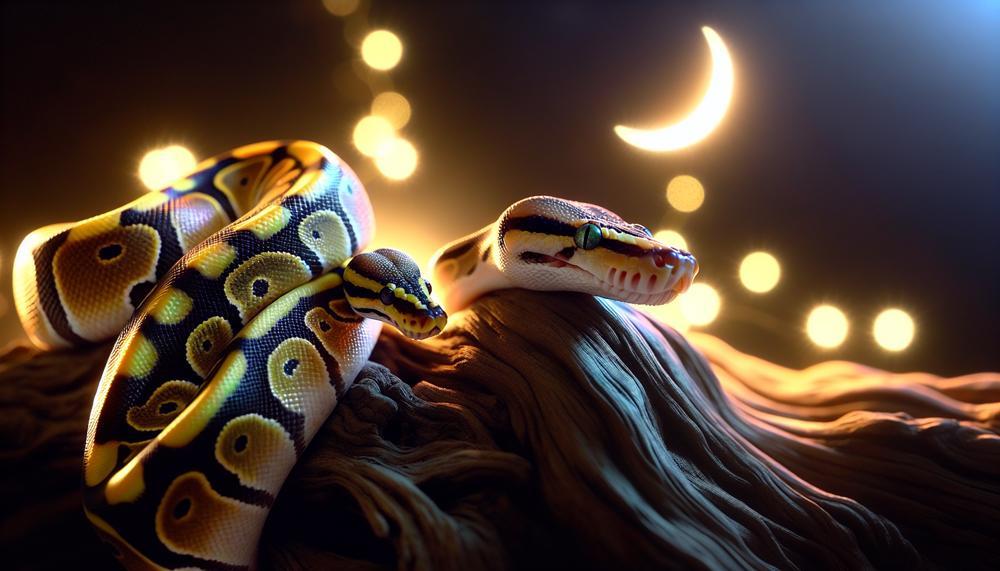
In addition to this unique sleeping preference, ball pythons have specific requirements for their sleeping environment. This includes having a warm basking spot, a cooler area, and a hiding spot where they can feel safe and secure.
It is crucial to maintain a consistent day and night cycle for these reptiles to keep their circadian rhythm in check. Any disruptions in their environment or routine can affect their sleeping patterns and overall health.
To understand why ball pythons have such a distinct sleeping pattern, it’s essential to look at their natural habitat. In the wild, these snakes live in the savannas and grasslands of sub-Saharan Africa, where temperatures can fluctuate drastically between day and night.
As a result, ball pythons have adapted to become primarily nocturnal creatures to avoid extreme temperatures during the day.
Moreover, ball pythons are ambush predators, meaning they rely on surprise attacks to catch their prey. This hunting behavior also aligns with their nocturnal nature, as many of their prey species are also active at night. Sleeping in a straight line allows them to quickly spring into action when an opportunity for food arises.
In captivity, it’s crucial to replicate these natural conditions for ball pythons to maintain good health and sleeping patterns. Providing a warm basking area and access to hiding spots mimics their natural habitat.
Additionally, maintaining a consistent day and night cycle can help keep these reptiles on a regular sleeping schedule.
Ball Pythons Have Specialized Eyes
Ball pythons possess unique eyes that are specifically adapted for their nocturnal lifestyle. These specialized visual abilities play a vital role in their survival and hunting in the wild.
| Prominent Eyes | Ball pythons have prominent eyes that enable them to capture more light in low-light conditions, enhancing their vision at night. This is because larger eyes provide a larger surface area for light to enter, giving them an advantage in detecting prey and predators in the dark. | Their prominent eyes aid ball pythons in seeing better in low-light conditions, contributing to their nocturnal behavior. |
| Monocular Vision | Unlike humans, who have binocular vision, ball pythons possess monocular vision. This means that each eye works independently, providing them with a wide field of view. This is beneficial for detecting movement and potential threats in their surroundings. | Their monocular vision allows ball pythons to have a broader field of view, assisting them in navigating and hunting in the dark. |
| Tapetum Lucidum | The tapetum lucidum is a reflective layer of cells found behind the retina in the eyes of ball pythons. This layer helps reflect light back onto the retina, giving it a second chance to detect photons. This enhances their night vision and allows them to see clearly in low-light conditions. | The tapetum lucidum plays a critical role in improving their night vision, enabling them to see clearly in the dark. |
| Lack of Color Vision and Limited Visual Acuity | Ball pythons lack color vision and have limited visual acuity. This means that they rely heavily on their other senses, such as scent and heat-sensing abilities, for prey detection. Their specialized eyes are better adapted for detecting movement and shapes rather than colors and details. | Their lack of color vision and limited visual acuity force ball pythons to rely more on their sense of smell and heat-sensing abilities for hunting prey at night. |
| Broad Field of View and Limited Depth Perception | The position of their eyes on the sides of their heads gives ball pythons a broad field of view, allowing them to see in multiple directions simultaneously. However, this also limits their depth perception, making it challenging to judge distances accurately. |
Nocturnal Ball Pythons Can Sense Infrared Heat
Nocturnal ball pythons have a special adaptation that allows them to sense infrared heat, which plays a crucial role in their survival. This unique ability is utilized in various ways during their nocturnal activities, such as hunting, mating, and thermoregulation.
Let’s delve deeper into how ball pythons use their infrared sensing to their advantage.
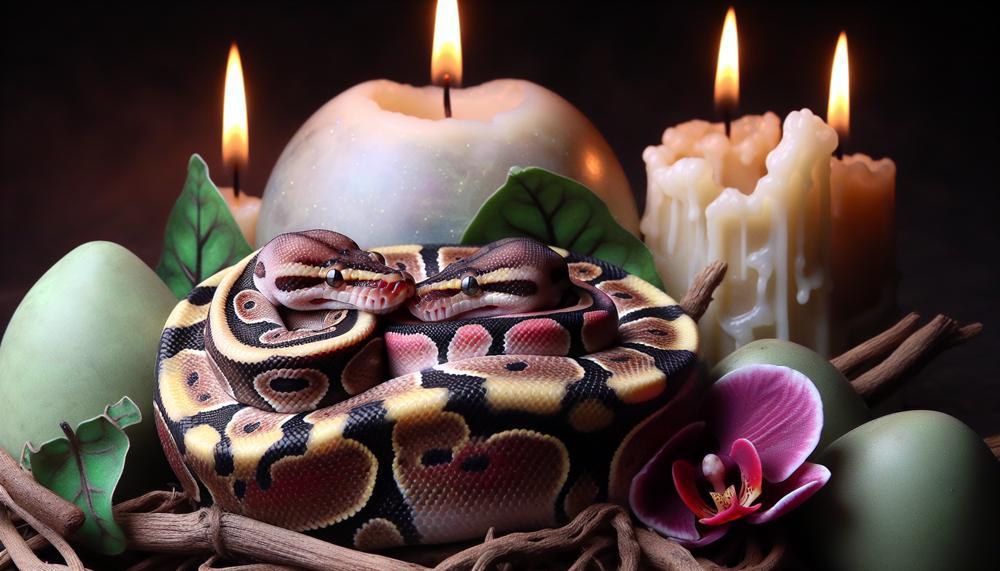
| Activity | How Infrared Sensing is Utilized | Explanation |
| Hunting | Sensing prey’s body heat | The pit organ of ball pythons enables them to detect the body heat of warm-blooded animals like rodents and birds. This helps them locate and strike their prey with precision, even in complete darkness. |
| Courtship and Mating | Finding potential mates | During breeding season, male ball pythons use their pit organs to detect the body heat of female pythons. This helps them find potential mates and determine if a female is carrying eggs or not. |
| Thermoregulation | Maintaining ideal body temperature | Infrared sensing allows ball pythons to regulate their body temperature by moving to warmer or cooler areas. This is crucial for digestion and overall health, especially during colder nights. |
| Other Senses Used at Night | Sight – large eyes and vertical pupils for enhanced night vision | Ball pythons have excellent night vision thanks to their large eyes and vertical pupils, enabling them to see in low-light conditions. |
| Smell – using tongues to detect chemical cues | Their heightened sense of smell allows ball pythons to detect chemical cues in their environment, helping them navigate and locate prey at night. |
Ball pythons rely on their ability to sense infrared heat in various ways during their nocturnal behavior. This unique adaptation enables them to thrive and survive in their natural habitat, making them successful and efficient predators at night.
Additionally, these reptiles also use their excellent night vision and heightened sense of smell to aid in their nocturnal activities. Their large eyes and vertical pupils allow them to see in low light conditions, while their sense of smell helps them navigate and find prey.
These senses, combined with their infrared sensing, make ball pythons highly skilled hunters and survivors at night.
Ball Pythons Use Pit Organs To Hunt in the Dark
Ball pythons, like other snakes, have a unique ability to hunt in the dark using their pit organs. These heat-sensing pits, located on each side of their mouth, allow them to detect small changes in temperature via infrared rays. This special sense gives them an edge in hunting prey at night, making them successful predators.
How Pit Organs Work:
The pit organs of ball pythons are highly sensitive to infrared radiation, which is emitted by warm-blooded animals and objects. When a ball python is on the hunt, it will actively scan its surroundings by flicking its tongue and using its pit organs to detect any source of heat.
The pits then relay this information to the brain, which interprets it as a thermal image. This allows the snake to locate and strike its prey with great accuracy.
Other Senses Used in Hunting:
While the pit organs play a crucial role in hunting at night, ball pythons also rely on their other senses to catch prey. Their excellent night vision allows them to see movement and shapes in low light conditions, while their heightened sense of smell helps them detect the scent of potential prey.
These senses work together to give the ball python a successful hunting experience in the dark.
A Personal Anecdote:
I once witnessed my pet ball python, named Monty, use his pit organs to hunt in the dark. I had turned off all the lights in my room, and Monty was coiled up in his tank, seemingly asleep.
Suddenly, he snapped into action and began moving towards a spot near the corner of his tank. I couldn’t see anything there, but Monty was clearly focused on something.
After a few minutes of intense concentration, he struck at something in that corner and successfully caught his prey. It was amazing to see him use his pit organs so effectively.
Pet Owners Must Ensure Their Ball Python Gets Enough Sleep
To do this, it is essential to provide a suitable enclosure, regulate temperature and lighting, monitor feeding schedules, and minimize handling at night. Additionally, observing your pet’s behavior and making necessary adjustments is vital for their overall health and happiness.
First and foremost, it is important to create a suitable environment for your ball python to sleep in. This includes providing a comfortable and secure enclosure with appropriate bedding, hiding spots, and perches. These elements mimic their natural habitat and help them feel safe and secure, promoting better sleep.
Furthermore, regulating temperature and lighting is crucial for maintaining a healthy sleep-wake cycle for your snake. Ball pythons are nocturnal creatures, meaning they are most active at night. Therefore, it is essential to keep their enclosure at a consistent temperature of 75–80°F during the day and slightly cooler at night. Similarly, providing a light schedule that mimics their natural environment can help regulate their sleep-wake cycle.
It is also important to monitor your ball python’s feeding schedule. Overfeeding can lead to obesity and other health issues, while underfeeding can cause stress and disrupt their sleep pattern. Finding the right balance is key to ensuring they are getting enough rest.
In addition to physical factors, minimizing handling at night is crucial for your snake’s sleep quality. Ball pythons are solitary creatures and prefer to be left alone during their resting hours. By limiting handling at night, you can reduce stress and allow them to get the rest they need.
Finally, as a pet owner, it is essential to observe your ball python’s behavior regularly and make adjustments accordingly. Each snake has its own unique sleeping habits, and by paying attention to their behavior patterns, you can identify any potential issues that may affect their sleep quality.
Ball Python Enclosure Requirements
Creating a suitable living space for a ball python requires meeting specific requirements for size, temperature, and humidity. These necessities are crucial for maintaining the health and well-being of these magnificent creatures.
Size:
The perfect size for a ball python’s enclosure is determined by its age and size.
For hatchlings and juveniles, a 36x18x18-inch enclosure is recommended, while adult ball pythons should have a larger habitat of 48x24x24 inches. This ensures that the snake has enough room to move around and explore its surroundings.
Temperature:
As ectothermic animals, ball pythons rely on external heat sources to regulate their body temperature. Thus, it’s essential to create a temperature gradient within the enclosure.
The warm end of the habitat should be maintained at 85-95°F, while providing a basking spot with temperatures up to 93°F. The cool end should be kept around 75°F.
Humidity:
Maintaining proper humidity levels is crucial for the well-being of ball pythons. The ideal range for these snakes is between 50%-60%.
This can be achieved by regularly misting the enclosure with room-temperature water or by using an automatic mister system.
Substrate:
Several options for substrate exist, such as sand or reptile bark. However, it’s crucial to consider the pros and cons of each before choosing one that best suits your snake’s needs. Regular cleaning and disinfecting of the substrate are necessary to prevent odors and bacterial growth.
Lighting:
Proper lighting is crucial for ball pythons. Using full-spectrum T5 UVB bulbs mimics natural sunlight patterns and is recommended. A photoperiod of 12 hours on and 12 hours off is ideal for these snakes.
Enclosure Accessories:
Aside from meeting the basic requirements, adding accessories like plants, rocks, foggers, branches, and decorative items can enhance the habitat and fulfill the snake’s needs.
Housing:
Ball pythons are solitary creatures and should not be housed together. A large water bowl for soaking should also be provided at all times to ensure proper hydration.
Monitoring:
It’s important to monitor the humidity levels daily and maintain them at 50%–60% for healthy shedding and respiratory function. Regularly checking the temperature and providing adequate hiding spots will also contribute to a comfortable and stress-free environment for your ball python.
Enclosure Type:
Both glass and plastic enclosures are suitable for ball pythons, as long as the necessary requirements are met.
Nocturnal vs. Diurnal: What’s the Difference?
Ball pythons, like most snakes, are creatures of the night. They are nocturnal, which means they are active at night and sleep during the day. However, there are notable behavioral differences between nocturnal and diurnal ball pythons.
Nocturnal ball pythons are more lively and alert at night, as this is when they hunt for food and mate. They have adapted to their environment by relying on senses other than vision, such as smell and infrared heat sensing. In addition, nocturnal ball pythons possess pit organs on their heads that enable them to sense heat radiation and quickly decide if something is potential prey.
On the other hand, diurnal ball pythons are more active during the day and sleep at night. They are less active than their nocturnal counterparts and prefer to spend their time basking in the sun or exploring their surroundings. Unlike nocturnal ball pythons, diurnal ones rely heavily on their sharp vision to hunt for prey, as they are pursuit predators rather than ambush predators.
In terms of sleep patterns, nocturnal ball pythons require more rest as they need to digest a larger amount of food due to their larger size. They do not have eyelids like humans do, but instead have a protective layer called a “brille” that covers their eyes while they sleep.
While both types of ball pythons have similar needs in terms of enclosure size, temperature, and humidity levels, it is crucial for owners to understand the normal behavior patterns of their snake. If a ball python shows signs of illness or unusual behavior, immediate veterinary care should be sought.
To summarize, while both types of ball pythons may have similar care requirements, there are distinct behavioral differences between nocturnal and diurnal snakes. Being aware of these differences can help owners provide the best possible care for their pet ball python.
Refer to the table below for a quick overview of these differences:
| Nocturnal Ball Pythons | Diurnal Ball Pythons | |
| Activity | Active at night, hunt for food, and mate | Active during the day, bask in the sun, and explore |
| Senses | Rely on senses other than vision, such as smell and infrared heat sensing | Rely on sharp vision for hunting prey |
| Sleep Patterns | Sleep for 20–23 hours per day; do not have eyelids but have a protective layer called a “brille.” | Sleep at night, have eyelids like humans do |
Conclusion
In conclusion, it’s safe to say that ball pythons are true nocturnal creatures.
Just like night owls, they thrive in the darkness of the night, utilizing their specialized eyes and pit organs to hunt for prey and navigate through their natural habitat. As pets, they may adjust their sleep schedule to match that of their owners, but they still require periods of darkness for a healthy circadian rhythm.
With their keen senses and ability to sense infrared heat, they have adapted to be skilled hunters in the dark. So don’t be surprised if you find your ball python sleeping during the day; it’s just saving its energy for an exciting night ahead.
Their mesmerizing behaviors and stunning appearance have captivated reptile enthusiasts worldwide, making them a popular pet choice.

